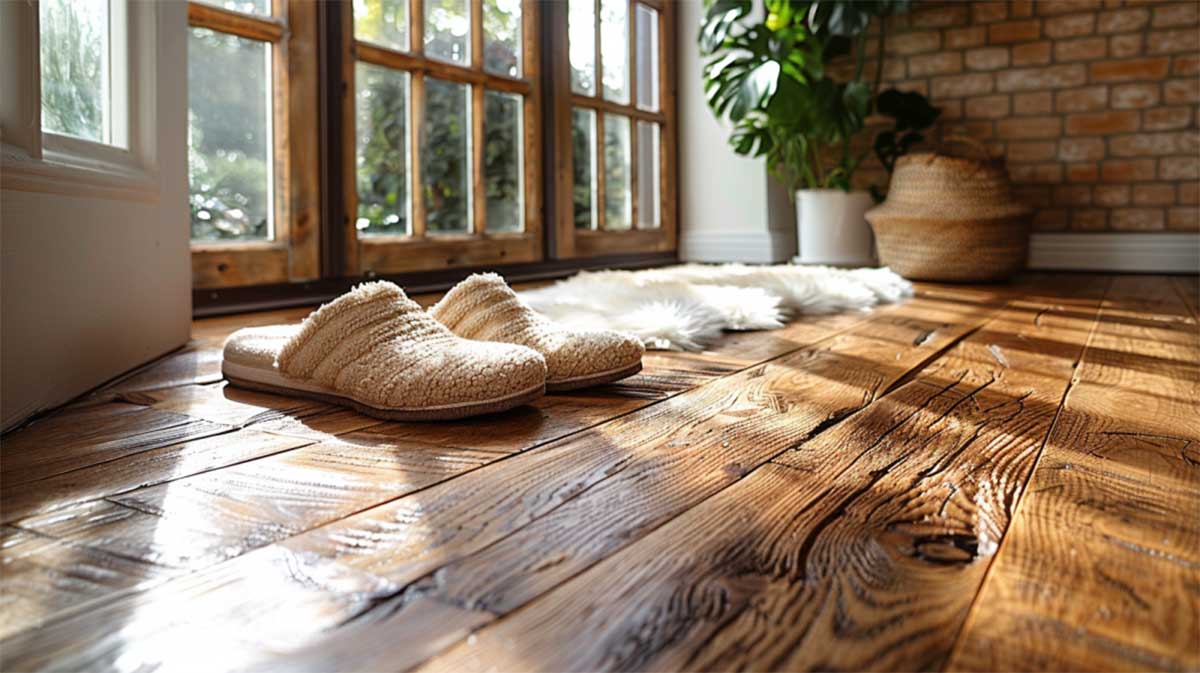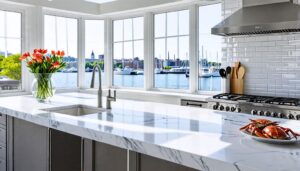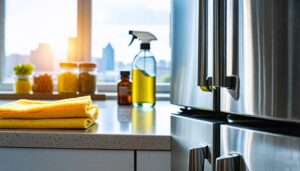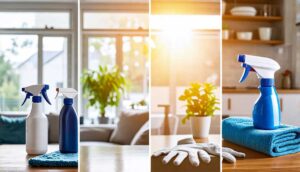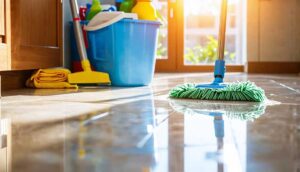Maintaining wood floors in high-traffic areas demands a multifaceted approach. Daily sweeping and prompt debris removal prevent surface abrasion, while strategic rug placement and furniture pads reduce wear. Regular inspections help identify wear patterns, enabling targeted maintenance. Moisture management is vital, as foot traffic introduces moisture that can damage floors. Annual deep cleaning preserves the protective finish, with high-traffic zones potentially requiring more frequent attention. Minor scratches can be addressed with wood blending pencils or matching stains, while significant damage may necessitate professional refinishing. A comprehensive maintenance plan is essential for preserving both aesthetic appeal and structural integrity. Investigate further for in-depth strategies to protect your investment.
Types of Wood Floors
When selecting wood floors for high-traffic areas, the choice between hardwood and engineered wood is essential. Solid hardwood offers longevity through multiple refinishing options, while engineered wood provides improved stability against moisture fluctuations. Popular wood species for high-traffic areas include oak and maple, which offer superior durability compared to softer alternatives.
Hardwood Vs. Engineered Wood
For high-traffic areas, the choice between solid hardwood and engineered wood floors is crucial. Both options have distinct characteristics that influence their performance under heavy use.
Solid hardwood floors, made from a single piece of wood, offer unparalleled beauty and longevity. They can be sanded and refinished multiple times, extending their lifespan for decades. However, they are sensitive to moisture fluctuations, which can be problematic in high-traffic areas prone to spills or varying humidity levels.
Engineered wood floors, with their plywood core and real wood veneer, provide improved stability and moisture resistance. This makes them suitable for a wider range of environments, including basements or areas with variable humidity. While they may have a shorter overall lifespan, they handle temperature changes better than solid hardwood.
| Characteristic | Solid Hardwood | Engineered Wood |
|---|---|---|
| Durability | High | Moderate |
| Moisture Resistance | Low | High |
| Refinishing | Multiple times | Limited |
Maintenance requirements differ between the two types. Solid hardwood typically needs refinishing every 7-10 years, while engineered wood requires less frequent sanding and refinishing. In high-traffic areas, both types demand regular cleaning and prompt attention to spills to preserve their appearance and structural integrity.
Popular Wood Species
Selecting the appropriate wood species is essential for ensuring longevity and performance in high-traffic areas. Oak, the most popular hardwood flooring choice, offers exceptional durability and wear resistance. Available in red and white varieties, oak withstands heavy use, making it ideal for high-traffic zones. Red oak, slightly softer than its white counterpart, still provides robust performance.
Maple, renowned for its hardness and fine grain, excels in areas subjected to frequent foot traffic. Its ability to resist scratches and withstand heavy use makes it a prime candidate for maintaining wood floors in high-traffic areas. Hickory, one of the hardest domestic hardwoods, offers superior resilience to wear and tear, making it an excellent choice for areas with significant foot traffic.
While cherry and walnut are valued for their aesthetic appeal, they may require more frequent maintenance in high-traffic areas due to their softer nature. Cherry’s rich color and unique grain patterns make it popular, but it demands extra care in busy zones. Walnut, with its deep tones and distinctive grain, is better suited for lower-traffic areas or as accent wood in flooring designs.
Impact of Foot Traffic
Foot traffic in high-use areas significantly impacts wood flooring through concentrated wear patterns and hotspots. The friction generated by shoes and other footwear causes surface abrasion, gradually eroding protective finishes and exposing the underlying wood. Additionally, moisture introduced from shoes, especially during inclement weather, can penetrate the wood surface, potentially leading to warping, cupping, or discoloration if not promptly addressed.
Wear Patterns and Hotspots
High-traffic areas’ wood flooring bears the brunt of daily wear and tear, resulting in distinctive patterns of deterioration. These wear patterns manifest as scratches, scuffs, and dullness, particularly in hallways, entryways, and dining rooms. Studies indicate that foot traffic significantly contributes to hardwood floor degradation, with heavier footfall accelerating finish deterioration and wood exposure.
Exacerbating factors in high-traffic areas include:
- Pets and high-heeled shoes
- Constant furniture movement
- Accumulated dirt and debris
High heels pose a particular threat, exerting up to 8,000 pounds of pressure and causing deep dents and scratches. Regular inspections of high-traffic zones are vital for identifying hotspots where wear is most prevalent, enabling targeted maintenance efforts before significant damage occurs.
Maintenance strategies should focus on these wear-prone areas, with more frequent refinishing recommended every 3-5 years, depending on traffic intensity. Proactive measures, such as strategic rug placement and furniture pad usage, can mitigate damage. Implementing a comprehensive maintenance plan that addresses these wear patterns and hotspots is necessary for preserving the aesthetic appeal and extending the lifespan of wood floors in high-traffic areas.
Friction and Surface Abrasion
While wood floors offer timeless beauty, they are particularly susceptible to the effects of friction and surface abrasion in high-traffic areas. Constant foot traffic generates friction that leads to surface abrasion, resulting in scratches and scuffs over time. The accumulation of dirt and grit from shoes not only contributes to surface wear but can also erode the protective finish of the wood, exposing the raw material underneath.
Regular maintenance is essential to mitigate wear and tear in high-traffic areas. The following table illustrates key factors and their impact on wood floors:
| Factor | Impact | Mitigation |
|---|---|---|
| Foot Traffic | Surface abrasion | Use area rugs |
| Dirt/Grit | Finish erosion | Regular cleaning |
| High Heels | Dents/Damage | Implement shoe policies |
| Debris | Exacerbated wear | Prompt removal |
High-heeled shoes pose a particular threat, exerting pressure of up to 8,000 pounds per square inch. This significantly increases the potential for dents and damage in high-traffic zones. To combat ongoing friction and maintain aesthetic appeal, the finish on hardwood floors may require more frequent touch-ups in these areas.
Moisture From Foot Traffic
Beyond surface abrasion, moisture introduced by foot traffic poses significant challenges for wood floors in high-traffic areas. As individuals traverse these spaces, they inadvertently bring in moisture from various sources, which can accumulate and lead to substantial damage if not properly managed. This moisture serves as a catalyst for dirt and grime buildup, accelerating wear and compromising the floor’s integrity.
The impact of moisture from foot traffic manifests in several ways:
- Swelling and warping of wood due to high humidity levels
- Penetration of water into wood fibers, causing staining and long-term structural issues
- Deterioration of the floor’s finish, increasing susceptibility to scratches and scuffs
To mitigate these risks, implementing a robust moisture management strategy is essential. This includes prompt cleanup of spills, regular monitoring of humidity levels, and the use of moisture-absorbing mats at entryways. Additionally, maintaining a consistent cleaning regimen helps remove moisture-laden dirt before it can cause significant damage. By addressing moisture-related concerns proactively, property owners can significantly extend the lifespan of their wood floors in high-traffic areas, preserving both their aesthetic appeal and structural integrity.
Preventive Measures
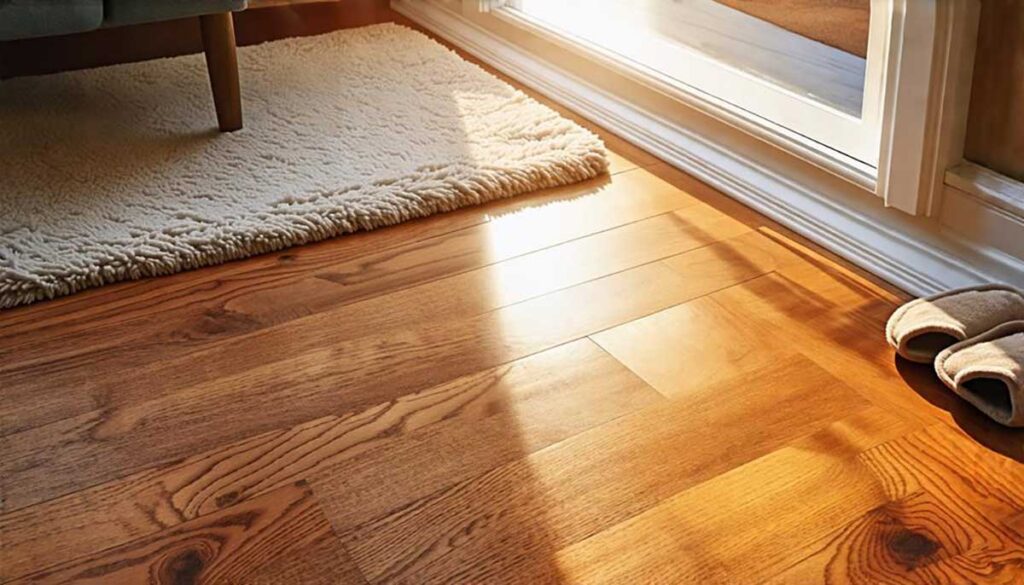
Implementing preventive measures is essential for maintaining wood floors in high-traffic areas. Strategic rug placement in zones with heavy foot traffic can significantly reduce wear and tear on the hardwood surface. Applying furniture pads to the legs of chairs, tables, and other heavy items prevents scratches and dents caused by movement or weight distribution.
Strategic Rug Placement
Through strategic rug placement, homeowners can significantly reduce wear and tear on wood floors in high-traffic areas. Area rugs serve as effective barriers against dirt and debris, trapping particles that would otherwise scratch and damage the hardwood surface. By absorbing the impact of foot traffic, these rugs protect your hardwood floors from dents and scratches caused by shoes and heavy objects.
To maximize the protective benefits of rugs in high-traffic areas:
- Choose rugs with non-slip backing to prevent movement and potential tripping hazards
- Place runners in hallways and entryways to minimize tracked-in debris
- Regularly clean or replace rugs to prevent dirt buildup
Strategic placement of rugs in key areas such as entryways, living rooms, and kitchens can significantly reduce the impact of daily wear. It’s vital to select rugs that complement the room’s aesthetics while providing adequate protection. Homeowners should prioritize rug placement in zones with the highest foot traffic to effectively shield the underlying wood flooring.
Regular maintenance of both the rugs and exposed wood surfaces is essential. Monthly cleaning of rugs helps prevent accumulated dirt from causing further damage to the floor. This proactive approach to floor protection can substantially extend the lifespan of hardwood flooring in high-traffic areas.
Furniture Pad Application
Consistently applying furniture pads is an important preventive measure for protecting wood floors in high-traffic areas. These simple yet effective accessories serve as a protective barrier between furniture legs and the floor surface, significantly reducing the risk of scratches and dents. By distributing weight more evenly, furniture pads minimize the concentrated pressure exerted on the floor, which is particularly significant in high-traffic areas where furniture movement is frequent.
Studies indicate that furniture pads can decrease impact force on floors by approximately 50%, underscoring their relevance in preserving hardwood integrity. This reduction in wear and tear extends the lifespan of wood floors and maintains their aesthetic appeal. To maximize effectiveness, it is important to regularly inspect and replace worn or damaged pads, as even a single exposed furniture leg can cause substantial floor damage due to its concentrated pressure. The installation of furniture pads is a straightforward process that yields significant benefits, particularly in busy spaces where floors are subject to constant use. By implementing this preventive measure, property owners can substantially mitigate the long-term effects of daily wear on their wood floors, ensuring durability and preserving value.
Cleaning and Maintenance Routines
Effective cleaning and maintenance routines are critical for preserving wood floors in high-traffic areas. Daily sweeping or dry mopping removes abrasive particles that can scratch the surface, while weekly cleaning with wood-specific products addresses spills and dust accumulation. Implementing a deep cleaning schedule every 6-12 months, using professional-grade methods, guarantees thorough removal of ingrained dirt and restoration of the floor’s luster.
Daily Sweeping Routine
A daily sweeping routine forms the cornerstone of effective hardwood floor maintenance in high-traffic areas. This practice is essential for removing dirt and debris that can cause scratches and compromise the floor’s protective finish. In high-traffic zones, multiple sweeping sessions may be necessary, particularly during inclement weather when tracked-in grit and moisture pose increased risks.
The benefits of a consistent daily sweeping routine include:
- Preservation of the floor’s protective finish
- Extended lifespan of the hardwood
- Reduced frequency of refinishing
To maximize the effectiveness of the daily sweeping routine, focus on corners and edges where dirt tends to accumulate. Employ a soft-bristled broom or a dry microfiber mop to gently collect debris without scratching the surface. For ideal results, supplement sweeping with periodic vacuuming using a soft brush attachment.
Implementing a rigorous daily sweeping regimen significantly contributes to the overall maintenance and aesthetic appeal of hardwood floors in busy environments. This proactive approach minimizes wear, preserves the floor’s finish, and guarantees the longevity of the wood surface, ultimately reducing long-term maintenance costs and enhancing the visual appeal of the space.
Deep Cleaning Schedule
Deep cleaning schedules play an essential role in maintaining the longevity and appearance of hardwood floors in high-traffic areas. While routine cleaning is vital, it may not sufficiently remove accumulated grime over time. To address this, annual deep cleaning is recommended for most hardwood floors, with high-traffic areas requiring more frequent attention every 6-12 months.
Professional deep cleaning services employ specialized equipment and techniques to effectively remove ingrained dirt and restore the floor’s finish. This process not only improves the floor’s aesthetic appeal but also significantly extends its lifespan, reducing the need for costly repairs and refinishing.
Implementing a regular deep cleaning schedule should be accompanied by thorough inspections to identify areas requiring immediate attention, such as scratches or dents. This proactive approach allows for timely intervention, preventing minor issues from escalating into major problems.
Repair and Restoration
Addressing minor scratches on wood floors can be accomplished using wood fillers or stain markers, providing a quick and effective solution for surface-level damage. For more extensive wear or deep gouges, professional refinishing may be necessary, involving sanding and reapplying protective coatings to restore the floor’s appearance and integrity. Regular assessment of high-traffic areas is essential, with experts recommending refinishing every 3-5 years to maintain the floor’s protective finish and overall condition.
Minor Scratch Fixes
Despite their durability, hardwood floors in high-traffic areas are prone to minor scratches over time. These imperfections, while often superficial, can detract from the floor’s overall appearance. Fortunately, several effective methods exist for addressing minor scratches and maintaining the floor’s aesthetic appeal.
For minor scratches, a wood blending pencil or stain matching the floor’s finish can effectively camouflage imperfections. Deeper scratches may require the application of a finish restorer to blend the damaged area with surrounding wood. Before applying any repair products, thorough cleaning of the affected area is essential for accurate damage assessment and proper product adhesion.
Key considerations for minor scratch fixes:
- Choose repair products that match the floor’s finish precisely
- Apply products sparingly to avoid over-treatment
- Test products in an inconspicuous area before full application
While DIY methods can be effective for minor blemishes, caution is advised to prevent further damage to the floor’s finish. Regular maintenance and prompt attention to scratches significantly extend the life and appearance of hardwood floors in high-traffic areas. By implementing these repair techniques and maintaining a consistent care routine, homeowners can preserve their wood floors’ beauty and functionality for years to come.
Professional Refinishing Options
When wood floors in high-traffic areas sustain significant damage or wear beyond the scope of minor repairs, professional refinishing becomes an essential option for restoration. This process involves sanding down the top layer of hardwood flooring to eliminate scratches, dents, and signs of wear, effectively restoring the surface to its original condition.
Professional refinishing is an important maintenance strategy for high-traffic areas, typically recommended every 3 to 5 years to preserve the aesthetic appeal and structural integrity of hardwood floors. This procedure can extend the lifespan of flooring by 10 to 15 years, depending on foot traffic intensity. The refinishing process often includes the application of durable finishes, such as polyurethane, which provide improved protection against future wear and tear.
Investing in professional refinishing not only revitalizes the appearance of hardwood floors but also significantly increases property value. By addressing cumulative damage and applying protective coatings, this restoration method guarantees that wood floors in high-traffic areas maintain their beauty and functionality for years to come, making it an integral component of long-term floor maintenance strategies.
Frequently Asked Questions
How to Protect Wood Floors in High-Traffic Areas?
To protect wood floors in high-traffic areas, implement a comprehensive maintenance strategy. Regularly sweep or vacuum to remove abrasive particles. Place strategic area rugs and runners to absorb impact. Use furniture pads to prevent dents. Address spills promptly to avoid staining. Conduct periodic inspections for early damage detection. Apply pH-neutral cleaners during routine damp mopping. Install high-quality doormats at entrances to trap dirt and moisture. Schedule professional deep cleaning and refinishing every 3-5 years to maintain the floor’s integrity.
How Do You Clean High-Traffic Areas on Hardwood Floors?
To clean high-traffic areas on hardwood floors, implement a multi-tiered approach. Daily sweeping or dry mopping removes abrasive particles. Weekly, use a damp microfiber mop with a pH-neutral hardwood cleaner, avoiding excess moisture. Address spills immediately to prevent staining. Place high-quality doormats at entrances to reduce dirt ingress. Perform annual deep cleaning using specialized equipment or professional services to restore shine and remove ingrained dirt. Maintain a consistent cleaning schedule to preserve floor integrity and appearance.
What Is the Best Finish for Hardwood Floors for High-Traffic?
Consider a bustling office lobby with hardwood floors subjected to constant foot traffic. For such high-traffic areas, the best finish is oil-based polyurethane. This durable coating provides superior wear resistance and longevity compared to water-based alternatives. Commercial-grade finishes incorporating aluminum oxide offer improved scratch and scuff protection. A satin or semi-gloss sheen is ideal, balancing durability with aesthetic appeal while concealing minor imperfections. Regular maintenance, including periodic resealing every 3-5 years, guarantees the finish’s continued effectiveness in high-traffic environments.
Is Hardwood Good for High-Traffic Areas?
Hardwood flooring is indeed suitable for high-traffic areas due to its inherent durability and resilience. Species such as oak and maple are particularly well-suited for heavy use, offering superior hardness and wear resistance. The application of robust finishes like polyurethane further improves hardwood’s performance in high-traffic settings. Regular maintenance, including cleaning and periodic refinishing, is essential to preserve the floor’s integrity. Engineered hardwood presents an alternative option, providing increased stability and moisture resistance for demanding environments.

